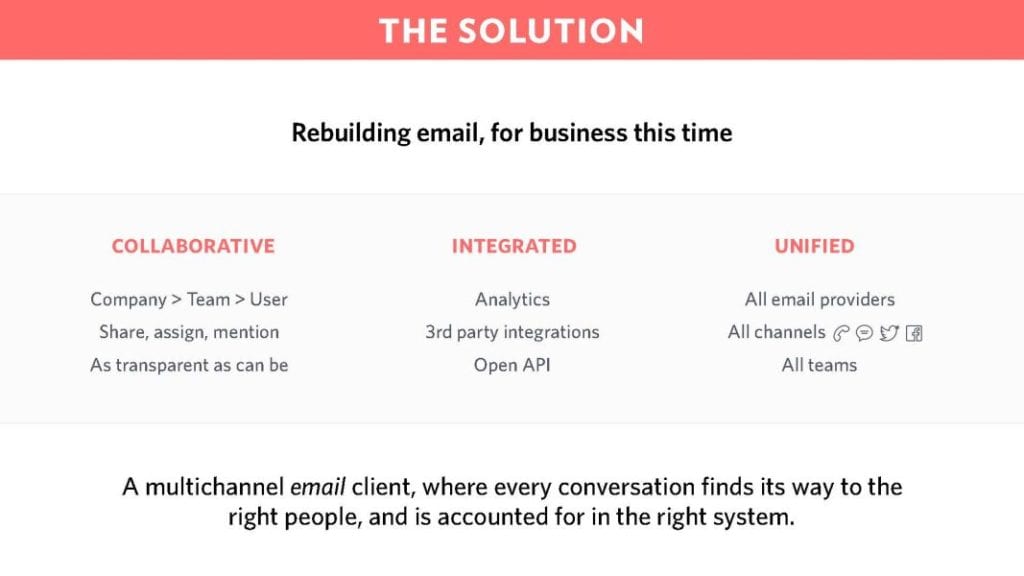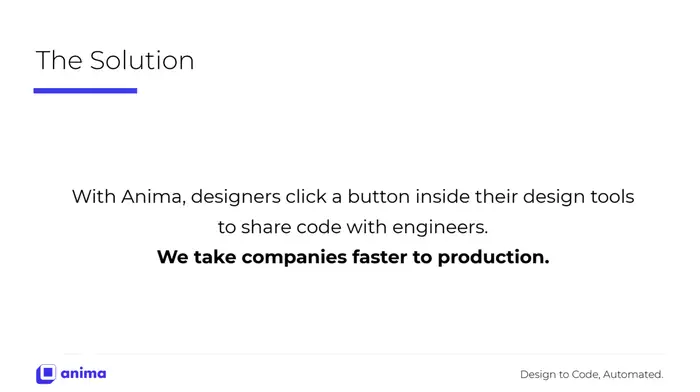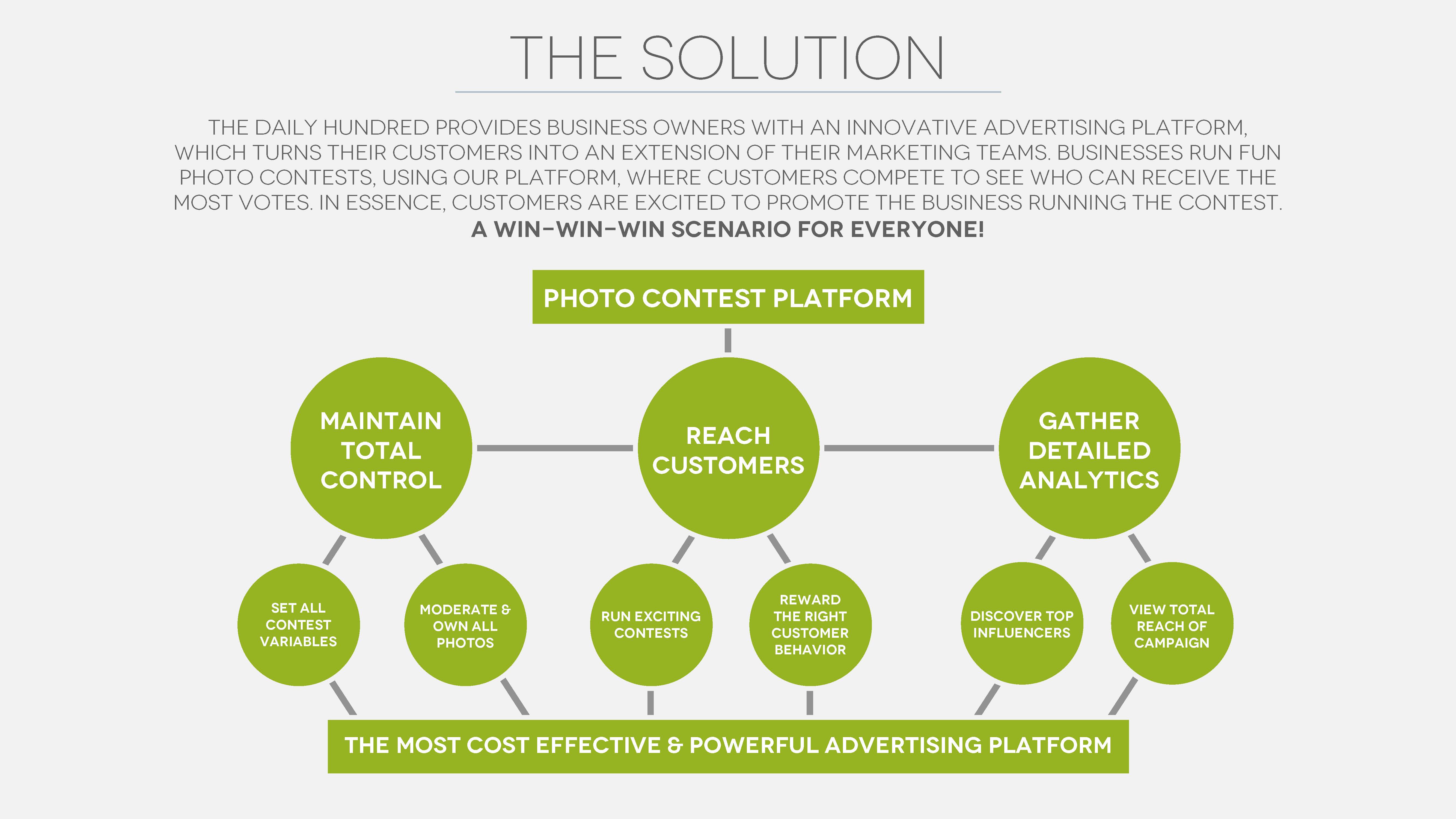Let's land you some funding.
Get Your Pitch Deck MadeStart Working With Keane
02
LEARN MORE

The solution slide in a pitch deck is a money slide.
What makes for a great solution slide?
The answer isn’t exactly straightforward.
First and foremost, a great solution slide clearly communicates your startup’s benefits and demonstrates how you solve the problems laid out on the problem slide.
After that, things get tricky.
To nail down a data-driven answer to this question, we analyzed the living heck out of 137 opinions from 20 startup investors and experts.
So, here are the eight things that make for an outstanding solution slide to build your next investor-ready pitch deck.
To start, we conducted a targeted online search to find reputable articles created by actual investors, pitch deck consultants, serial entrepreneurs, and startup publications.
Next, we segmented those opinions into eight buckets:
(percentages represent the proportion of opinions that feel into a given bucket)
Since the opinions we analyzed were diverse, we’re going to place more emphasis on the first three categories in this post. We will also briefly touch on the remaining categories as secondary suggestions.
Let’s dive into the research.
A good pitch deck solution slide should have a strong connection to the problem laid out.
In theory, it sounds simple enough: Your company solves a problem that many people have.
But in practice, founders often jump right into a grandiose solution or vision statement that doesn’t fully align with their problem statement.
Problem tie-in is important because it shows that you understand the pain points of your potential customers and are offering a solution for them.
The problem slide sets the tone for the entire pitch deck’s narrative, as everything that comes after should flow from it. This positions your startup as the much-needed hero in an industry with unmet needs.
Investors in our study suggest reverse-engineering the problem statements to create powerful benefit statements for the solution slide. Startup publication Innovation Bay says:
“Your solution is a simple explanation of what your product is and how it’s going to solve the problem laid out in your prior slide. Be mindful of how you present this information—you want it to be a direct response to the problem, perhaps even visually linking the two slides so that your solution is immediately understood.”
This category ranks number one in our study with 28% of opinions and showed that investors unanimously expect cohesion when it comes to the problem and solution slides.


In the example above, Aircall provided an overview of current phone solutions for businesses. They tie in each problem statement bucket to the solution slide to show an unmet need in the market by reverse-engineering each and even keeping the layouts of both slides similar.
People are visual learners, and investors are no different.
In our previous reports, we’ve shown that experts describe pitch decks as a “backdrop” for live investor presentations. Therefore, investors believe visuals are important when discussing the company’s solution.
Some resources suggested adding photos, videos, GIFs, and even live demos to show investors how the solution works. This category ranked second in our study with 25% of mentions.
At STORY, we usually have a singular hero visual on the solution slide that talks about the benefits of the solution. Then, we provide more detail on functionality on a few “how it works” or “product” slides following the solution slide.
“Screenshot(s) or videos are preferred. There is nothing better than ‘showing’ instead of telling.”
— Iskender Diri, VC

The sample slide above is from Divvy’s 2019 pitch deck. They used a graphic to visually explain the concept of fractional homeownership and how easy the transaction is for the tenant.

Similar to the Series-A deck of 1906 (a cannabis startup), startups with physical products can use the solution slide as an opportunity to showcase on-brand product shots.
Investors want to hear a concise story that gets straight to the point without wasting time.
They don’t have time for boring stories and want something that will capture their attention immediately. Investors are looking for innovative ideas that can change lives or businesses forever, so it’s important to grab their attention immediately.
In the past, we’ve uncovered how important brevity is to investors. Concise copy has been mentioned in almost every study we’ve conducted.
The solution slide is no different.
In fact, a DocSend study revealed that investors only spend 2 minutes and 43 seconds reading a pitch deck. Using the average words-per-minute reading speed of a 15-slide pitch deck means that each slide should have no more than 66 words.
However, this category doesn’t only apply to copy. Founders must also be wary of overloading the slide with too many visuals.
A great solution slide is quick and easy to understand. The faster the investor understands the solution, the better. This category ranked third in our research, with 15% of opinion mentions.
“A common mistake that fundraisers make is to over-complicate their pitch deck solution slides. Never do that. This slide is to answer the question of what you do and how you solve problems. Don’t include heavy charts and graphs on this slide— doing so may just overwhelm, confuse, and distract the investors away from your core function.”
— Feedough, Startup Publication

This 2016 Series-A pitch deck from Front showcases the solution’s high-level benefits and features in short, concise phrases.
Now that we’ve tackled the top three most mentioned categories, we’ll discuss the remaining opinions in the section below. Since each of these categories garnered less than 10% of mentions, we believed these to be “nice-to-haves,” and keeping these in mind while writing solution slides could be advantageous.
IPs and patents are important to investors. They want to know if your solution can be replicated by competitors. This category ranked fourth with 7% of all mentions. We believe that proprietary tech isn’t a priority, but mentioning it can be advantageous.

As mentioned earlier, the problem slide discusses the target market’s pain points. Thus, investors want startups to talk about the solution’s benefits to the customer—how it solves their problems.
Emphasizing the solution’s relevance to the target market ranked fifth in our study with 7% of mentions. Similar to the previous category, customer-centricity is more of a strong suggestion.

How is the solution different from alternatives that currently exist? This is the question that investors seek to answer. Investors know that every startup has a competitor— regardless if the founders are aware. Our study reveals that investors seek companies who can thrive in a crowded market. Competitive advantage can come in the form of proprietary technology, accessibility, practicality, and more.
The competitive advantage category received 6% of mentions as investors want to know the startup’s secret sauce.

Lastly, some investors wanted the solution slide to go hand-in-hand with the product slides—which usually come shortly after the solution slide. Tying in the solution (benefits) with the product (features) provides a transition into the more tactical elements of how the solution works. This category ranked last with 4% of mentions.

Now it’s time to talk about everything else we saw. This was the “catchall” bucket for opinions that didn’t seem to fit into any category. Under this, suggested tips included:
The research we conducted provided some insight as to what investors expect from solution slides.
Despite having diverse opinions, we found that the solution slide can only be as effective as the problem slide that it’s tied to.
Both slides must work cohesively together.
Moreover, the solution slide is the perfect opportunity to bring your product or service to life visually.
Lastly, investors stressed the importance of brevity. Avoid overcrowding this slide—and any other slide, for that matter—as less is more in the world of pitch decks.
Investors are usually looking for signs that you understand your customer’s needs, that you value their input, and that you can effectively solve the problems they’re facing.
Nailing the solution slide may not guarantee that investors will invest, but it may help you communicate what you’re trying to do as effectively as possible.
Learn how to write the FIVE most crucial fundraising sentences for your startup.
Buy Now - $47We ensure your deck has everything in it that investors look for so your startup can land more meetings more often.
We’ve written hundreds of decks since 2018; we know what works, what doesn’t, and how to embody the tone you’re going for.
For most startups, your brand begins with your pitch deck. We work with existing brands, and even create brand-new ones.
Sign up and get the knowledge you need to succeed.





